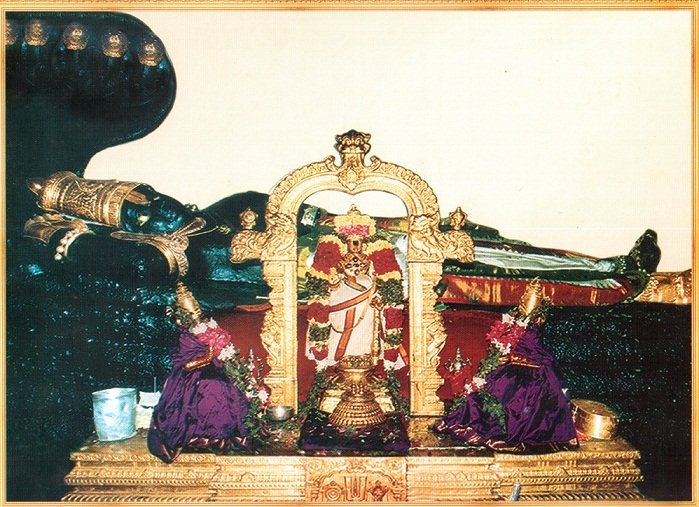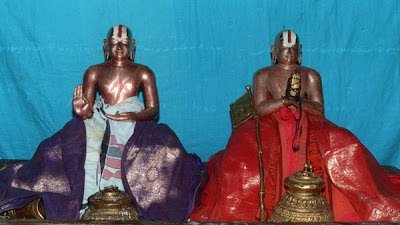We are in the midst of enjoying the divine glories of AzhwArs/AchAryas who appeared in this auspicious month of aippasi. Please view https://granthams.koyil.org/aippasi-thula-masa-anubhavam/ for full glories of this month. We shall now get a glimpse of our most merciful piLLai lOkAchAryar and his divine work thathva thrayam (tattva trayam) through the most beautiful vyAkyAna avathArikai (introduction to commentary) of maNavALa mAmunigaL for this master piece.

thathtva thrayam is glorified as kutti bhAshyam (miniature version of srI bhAshyam). emperumAnAr wrote detailed commentaries for braham sUthram which became to be famously known as srI bhAshyam and emperumAnAr became to be famously known as srI bhAshyakArar. This is because, it contains all the essential principles of our visishtAdhvaitha sidhAntham in the most comprehensive way as outlined in srI bhAshyam in easily understandable sUthrams (aphorisms) in thamizh. This grantham discusses the three fundamental principles namely chith (jIvAthmAs), achith (matter) and Isvaran. A brief summary of this grantham can be viewed at https://granthams.koyil.org/thathva-thrayam-english/.
With this background, let us now see the translation of thathva thrayam’s wonderful introduction given by mAmunigaL.
As mentioned in “anAdhi mAyayA suptha:“, since time immemorial, jIvAthmAs in this samsAram due to their connection with matter which causes ignorance (darkness), their intelligence being totally subdued, exist without understanding that jIvAthmA‘s nature is different from matter (i.e., filled with knowledge and bliss and fully exist for the pleasure of bhagavAn only).
Without the proper understanding,
- the jIvAthmA thinks “dhEvOham manushyOham” (I am a dhEva, I am a human) and considers the insentient body as the same as the self
- even if he understands that he is different from the body, as said in “IsvarOham aham bhOgi” (I am the controller and I am the enjoyer), he starts thinking that he is fully independent
- even if he understands that he is a servitor of bhagavAn, he still engages in worldly pleasures instead of constantly engaging in kainkaryam
As said in “yOnyathA santhamAnam ananyathA prathipathyadhE, kim thEna na krutham pApam chOrENAthmAbahAriNA“, jIvAthmA misunderstands the true nature of the self and commits the biggest of all sins (which is the cause of all other sins), i.e., stealing jIvAthmA which is the property of bhagavAn (considering bhagavAn’s property as ones own) and engages in enjoying worldly pleasures which are insignificant and temporary.
As said in “vichithrA dhEha sampaththir IsvarAya nivEdhithum, pUrvamEva kruthA brahman hasthapAdhAdhi samyuthA“, when the jIvAthmA is in a subtle state (during layam) just like matter (intelligence fully subdued) without any senses/body and not being able to engage in worldly enjoyment or efforts towards emancipation, the most merciful sarvEsvaran, blesses the jIvAthmA with senses/body to begin the process of approaching bhagavAn‘s lotus feet.

The jIvAthmA, instead of using the senses/body to approach bhagavAn to be uplifted, as said by nammAzhwAr in thiruvAimozhi 3.2.1 “annAL nI thantha Akkaiyin vazhi uzhalvEn“, goes by the bodily/sensual pleasures, just like a person who was given a raft to cross the river goes with the flow of the water and falls into ocean, the same senses/body that were given to the jIvAthmA to be uplifted from this samsAram were used to engage in samsAram more and more. The jIvAthmA, since time immemorial, has accepted many many births due to endless virtues/vices which was caused by ignorance. In those births, he goes through most miserable sufferings (thApa thrayam – 3 types of sufferings) and without understanding the effects, he engages in karmA and goes through several stages such as garbha (being in the womb), janma (taking birth), bhAlya (being a child who cannot take care of himself), yauvana (youth which is fully focussed on sense enjoyment), vArdhaka (old age), maraNa (death) and naraka (life in hellish planets) and goes through endless sufferings. Seeing that the jIvAthmA is suffering through endless miseries in this ocean of samsAram (which is filled with troubles), the most merciful bhagavAn, who is the well-wisher of everyone and who is constantly making efforts to uplift the jIvAthmAs, sympathises for the sufferings of jIvAthmAs as mentioned in “Evam samsruthi cakrastthE brAmyamANE svakarmabhi: jIvE dhukkAkulE vishNO: krupA kApi upajAyathE“. Out of great compassion in his divine heart, as mentioned in “jAyamAnam hi purusham yam pasyEn madhusUdhana: sAthvikas sa thu vigyEyas sa vai mOkshArththa chinthaka:“, bhagavAn blesses jIvAthmA at the time of birth which leads to inquiring on how to be uplifted from this samsAram. For a mumukshu (one who desires mOksham), there is no possibility to attain mOksham without the proper understanding of the true knowledge.
One can learn the true knowledge in two ways: from sAsthram and through upadhEsam (from preceptors).
- Learning from the sAsthram has the following limitations:
- As said in “sAsthra gyAnam bahu klEsam” – since sAsthram is endless and there are many seemingly contradictory statements, for a common man, it will be difficult to easily study the sAsthram and understand the purports. That is why this is difficult to pursue.
- Even if one is prepared to undergo difficulties in studying sAsthram, as said in “ananthabhAram bahuvEdhithavyam alpachcha kAlO bhahavachcha vignA:“, there is so much to learn, but jIvAthmAs (bound souls) have limited intelligence and a limited life span and there are so many hurdles while trying to study sAsthram.
- Finally, even though women and shUdhras qualify to be mumukshus (one who desires for mOksham), they are not qualified to study sAsthram.
- Learning from preceptors have none of the above limitations (as they understand the essence and purport of the sAsthram and transmit the same to the disciples/students in very simple language).
- fully free from any ahankAram (ego)
- always thinking about the well-being of all jIvAthmAs
- never looking for any personal fame, glory, etc.
- Even though AzhwArs were said to be EkagaNtar (one neck with many faces – meaning they all talk about the same principles), by seeing many AzhwArs talk about the same principle, the principle becomes more trustworthy – if many of (trustworthy) persons glorify a particular object, the object becomes well established. Similarly, AchAryas also being EkagaNtar explain the same principles in various granthams so that even the least-intelligent person will also look at several great personalities write about the same principle and become convinced about the validity of the same.
- Also, what is discussed briefly in one grantham will be discussed in detailed in another grantham. So the different granthams are complimentary to each other.

Thus
ends the most magnificient introduction section for thathva thrayam. This grantham is greatly glorified for presenting the most complicated principles of our visishtAdhvaitha sidhAntham in the simplest possible way. With mAmunigaL‘s beautiful and precise commentary, this is a great treasure for us to cherish. It is most beneficial if this grantham is
heard under an AchArya to understand the principles fully. Let us bow
down at the lotus feet of these great AchAryas and be blessed.
Previously, the three principles – chith (jIvAthmAs), achith (matter) and Isvaran were discussed in very simple terms and the same can be viewed at https://granthams.koyil.org/thathva-thrayam-english/.
In hindi: https://granthams.koyil.org/2013/10/aippasi-anubhavam-pillai-lokacharyar-tattva-trayam/
In thamizh – https://granthams.koyil.org/2017/09/20/aippasi-anubhavam-pillai-lokacharyar-tattva-trayam-tamil/
In telugu – https://granthams.koyil.org/2018/01/08/aippasi-anubhavam-pillai-lokacharyar-tattva-trayam-telugu/
In kannada – https://granthams.koyil.org/2021/12/30/pillai-lokacharyar-thathva-thrayam-intro/
Please share original version in Manipravaaham.